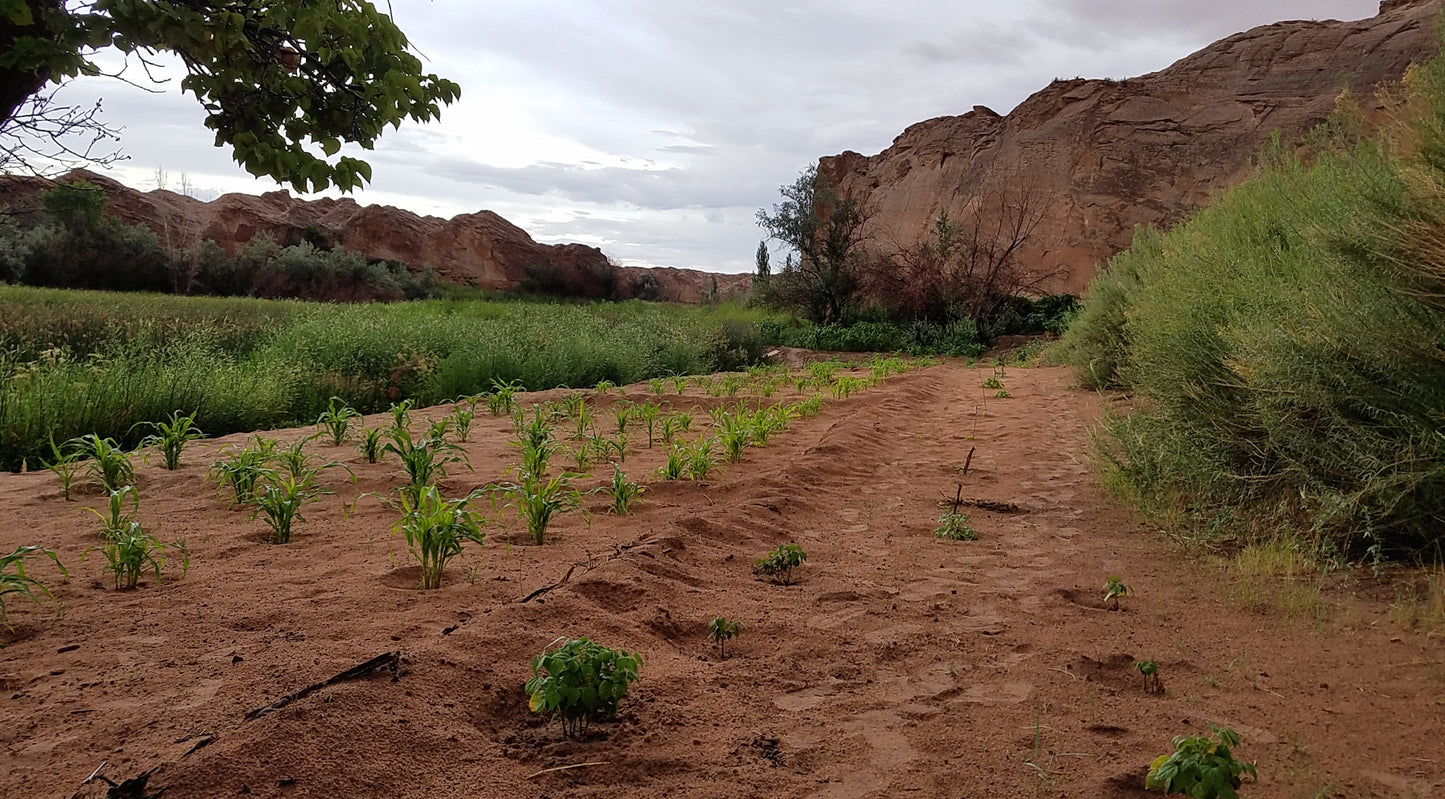
By Nicholas Garber, Conservation Program Manager.
With summer obviously in full swing in Tucson, this seems like a perfect time for an update on our Adopt-a-Crop tepary beans! These low-desert survivors thrive in the monsoon season and show that the monsoons are a season of abundance, which can reward working hot, muggy mornings with cooling greenery and nutritious, fresh foods.
First up is news from the Conservation Center garden where we planted Pima Beige and Brown tepary beans at our Día de San Juan breakfast. Thanks so much to the 40+ members who joined us to plant our waffle beds with beans and Día de San Juan corn, another traditional Tohono O’odham variety. These desert natives greeted the monsoons with shoots emerging 3 days after planting! Our beans are flourishing as they cool and infuse our soils with nitrogen to the benefit of every crop that will follow. If you have avoided planting in this monsoon season before, please stop by the center during the week for a visit to see how planting the right plant in the right place and at the right time is the foundation for success.

Tepary beans and corn sprouting three days after planting

Conservation Center garden, summer 2018
Last week, Sheryl and I also had the privilege of visiting Jeremy King, one of our partner farmers, at Hopi where he is growing the Hopi White tepary bean. We planted the Hopi White tepary bean along with Hopi sweet corn, white limas, and purple string beans along a terrace in Pasture Canyon that has been cultivated for more than 1,000 years. I tend toward the superlative in my language, but this may truly be the MOST BEAUTIFUL FARM I HAVE EVER VISITED. We lingered in the pouring rain to observe how Jeremy’s hand-built terraces slowed the water running down canyon walls, and the plants flourished among wild asparagus and 150-year-old naturalized Concord grape vines. Jeremy tucked planting basins in among cattails and Russian olives to protect tender seedlings from harsh winds and unabated sun, but also to harmoniously balance the plants we are tending in a larger landscape that sustains birds, snakes, bees and a diversity of wild and naturalized plants (Poliomintha, wild mint, watercress, and traditional medicines). The beans came up early and many animals suffering through the drought at Hopi grazed the young plants for food. We will replant some of the basins hoping for a larger harvest now that the monsoons have restored wild plants for hungry critters to feast upon.

Wild asparagus, beans, and corn growing at Hopi
But our monsoon season tepary bean update doesn’t end there! On Tuesday, four of us headed to Willcox to test another use for tepary beans – cover crop! Sarah and Rob at Sand Reckoner winery have been looking for the right cover crop for the rows of their vineyard. A good cover crop should use little or no additional irrigation, help shade the soil for topsoil retention, be cooling, suppress weeds and improve the soil with organic matter and nutrients. Cultivated tepary beans are incredible survivors, but ancient Tohono O’odham farmers carefully selected our modern landraces from wild ancestors. These wild tepary beans dot the landscape of southeastern Arizona and maintain a number of traits we hope to capitalize on growing them as cover crops. For the Sand Reckoner winery we selected the San Pedro wild tepary bean because it was originally collected very near the winery. It’s seeds can go unnoticed by wildlife as they look like pebbles and almost identically match the color of soils in the area, but – most importantly, this plant has learned to flourish in the monsoonal rainfall patterns of that area. Like all Fabaceae, these wild teps have root-associated bacteria which fix nitrogen in excess and actively improve the soil. Knowing that every season is different, we are prepared to supplement the watering schedule if needed, but we hope to water the seeds first with the forecasted rains this weekend and observe how the parents of the cultivated tepary might help farmers while helping us maintain wild biodiversity and a stock of healthy seeds for this remarkable plant.

Nick and helpers planting wild teps at the vineyard
Thanks so much for your continued support, and stay tuned for more introductions to and updates from our Adopt-a-Crop farmers!
